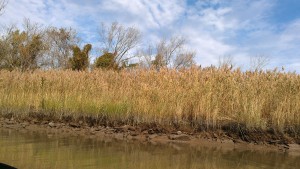Chris is currently pursuing his Masters in Conservation Biology at E3B, Columbia University
Chris has extensive past experience in salt marsh ecology, having worked as a research assistant with the Marine Biological Laboratory’s TIDE Project in Plum Island for several years. The research he was involved with there focused on the effects of ecosystem-wide nutrient enrichment.
This summer, he will be investigating the below-ground interactions between the invasive strain of common reed, Phragmites australis, and the native marsh species Typha angustifolia, Spartina alterniflora and Schoenoplectus americanus, within Piermont Marsh, a tidal wetland on the Hudson River.
Updates
Phragmites: Spatial bullying or chemical warfare?
Chris will now also be considering the potential effects of gallic acid within his experimental pots. Gallic acid, potentially emanating from the Phragmites roots and rhizomes, has allelopathic effects on surrounding plant biomass, and he’ll be hoping to tease out whether Phragmites gains its apparent competitive advantage by purely physical means, or whether soil chemistry is also playing a part. Interestingly, there is evidence (Bains et al. 2009) to suggest that the microbial communities harbored by the native plants themselves can exacerbate the breakdown of gallotannins in the Phragmites to the harmful gallic acid, hastening their demise in a tragic example of a negative feedback loop.
So, is Phragmites just a bully in the playground or does it have an extra chemical weapon?
Read more about the project from the man himself on his blog.


